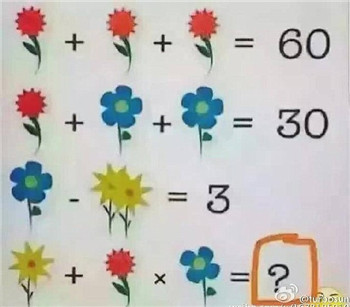It was the seemingly simple maths puzzle that left the Internet baffled.
之前难倒一片网民的正是一道看似简单的数学题。
The equation, which uses flowers instead of numbers, went viral with thousands of Facebook users debating the correct answer.
成千上万的脸书用户就一道用花代替数字的等式问题展开了激烈的讨论。

Daily Mail Australia put it to Associate Professor Leon Poladian, from the University of Sydney's mathematics department, who came back with a solution - but even he had to admit, it was a bit of ahead-scratcher.
每日邮报澳大利亚版块找到悉尼大学数学系的副教授里昂·波拉迪安,他解决了这道难题,不过即便是他也不得不承认,这题有点伤脑筋。(确定不是费眼神?)
Professor Poladian noted that the 'trick' to the puzzle lay in that the blue flower on the final line only had four petals, not five.
波拉迪安教授指出这道题的陷阱在于最后一行中的蓝色花朵仅有4片花瓣,而非上两行的5片花瓣。
In the puzzle, which is posted as a graphic, there are three lines showing what different combinations of flowers add up to. Then a new combination is shown, with no total, and it's up to people to work out the answer.
在这道以图片形式登出的数学题中,列出了三行不同的花朵组合。而最后一行出现的新型组合没有总和,得靠人们(根据前两行的总和)算出这个答案。
Wrong: People have given a number of different answers on the Facebook posts, with many of them incorrect
答错了!脸书上人们给出各式各样的答案,而许多都没有答对。
Because the puzzle tells us that the red flower is worth 20, a blue flower with five petals is worth five, and two yellow flowers are worth two.
因为这道难题表明一朵红色小花的值是20,5瓣的蓝色小花的值为5,而两朵黄色小花的值是2。
In the final line there is one yellow flower added to one red flower multiplied by one blue flower with four petals, making the equation 1 + 20 x 4.
最后一行中是一朵黄色小花加上一朵红色小花与一朵四瓣蓝色小花的乘积,因而由1 + 20 x 4可算得答案,即81。
However, Professor Poladian did warn that puzzles like this can have more than one correct answer, as there is not enough information to confirm that the number of petals on a flower changes its value.
不过波拉迪安教授还特意称像这样的题目能有不止一个正确答案,因为题中没有足够的信息能确认花瓣的数量会改变一朵花所代表的数值。
If you were to disregard the number of petals on the blue flower, you would come up with an entirely different answer of 101.
如果你不去管蓝色小花的花瓣数,那么你就会得到一个完全不同的答案:101。











